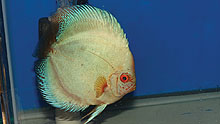WHAT'S NEW ACROSS THE WORLD
Select date in side bar to go to a What's New of previous issues
| What's New
©by Laif DeMason
Long term power loss is always problematic for hobbyists with multiple aquarium set ups. Hopefully all cichlid keepers (and their cichlids) pulled through the recent devastation of Hurricane Sandy in the northeast part of the USA. When serious weather approaches, it is best not to feed any fish regardless of size for two days prior to long power outages. When cold is also a threat with no power, most cichlids will be OK down to 55°F. Insulating your fish room or tank can help. When normal temperatures and power are restored, do a preventative Ich treatment about one week after the low temperatures. It is always best to have a small portable generator and be sure to drain out all gasoline when stored for later use!
Here’s “what’s new” on the cichlid scene:
|
Lake Tanganyika
Collections continue around the lake for wild Tanganyika cichlids. While the normal areas of Zambia and Tanzania are harvested; occasional collections in the Congo continue, recently even the northern, seldom visited areas of the Congo. Wild Tropheus sales have slumped a bit forcing collectors to newer areas for new color morphs. Wild Altolamprologus continue to be in good demand.

The “albino” form of Aulonocara stuartgranti ‘flavescent’ is often sought by hobbyists who favor albino cichlids. While some of these fish seem to have red eyes when viewed from certain angles, a dark stripe is present in the dorsal fin. There are many types of albinism for different pigments that are lacking. Perhaps this fish is albino for black, but not dark blue?
|

Recently a store owner asked me for some OB Dimidiochromis compressiceps. He said hobbyists always ask for classic morphs of many different cichlids, including OB and albinos. Gauging by the short body length and shape of this fish, it is a hybrid of some sort. Of course no OB morphs of D. compressiceps are found in the lake!
|

A real oddity, Alcolapia alcalicus is found in Lake Natron a soda lake in Tanzania and the surrounding area. This tilapiine was likely collected by avid hobbyists, then bred and distributed to others in Europe and America. Lake Natron’s water parameters are extreme in dissolved minerals, pH, and temperatures, but this fish is happy in more neutral aquarium conditions.
|

Unique aquarium strains of domestic discus fish continue to be developed by man. Many of the newest strains are very different from the original color forms of wild discus found in Amazonia. Here a new discus strain called White Butterfly; it displays an overall cream color with a red eye, red facial markings, and red caudal highlights, along with shiny turquoise fins.
|
Select date in side bar to go a What's New of previous issues
|



